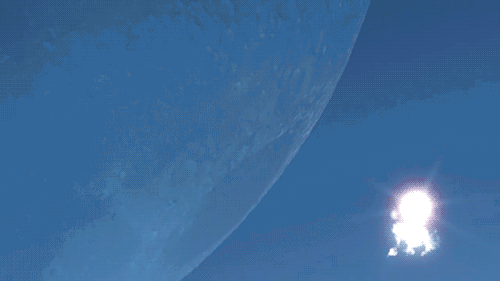Video
youtube
What is the shape of molecules? Third video by George Zaiden and Charles Morton.
First video
Second video
7 notes
·
View notes
Photo


What if the moon was the same distance away as the ISS?
That’s the question asked, and answered, in this new simulation by YouTuber yetipc1. While we think of the International Space Station as being, well, way out there in space, it’s not that far. Only around 400 km up, actually. If the Earth was a basketball, then the ISS would only be about a centimeter off its surface.
On average, our moon resides 384,400 km away from Earth (I say “on average” because its orbit is an ellipse, rather than a circle). For our basketball-Earth, that puts the tennis ball-sized moon at the NBA three-point line. That’s hard to picture, so here’s a video from Veritasium to help. Even at that incredible distance, it sucks on our oceans with its gravity, daily pulling the tides in and out.
Think about that! Even at that incredible distance, the moon can warp the liquid on the surface of Earth! Which brings me to a major problem with this video … in order to see this, we’d all be dead, and Earth would be very messed up indeed.

When two large astronomical bodies get close enough together, the pull of gravity and tidal forces will eventually warp the less massive of the two until it disintegrates. This magical distance is described as the Roche limit (although it’s also dependent on what each body is made of). Mars’ moon Phobos will likely meet this fate within 10 million years, falling apart into a ring system around our neighbor.
In the ISS/moon video, this would have already happened. So it would look more like Ron Miller’s beautifully imagined Earth-ring system. I also recommend his series on what we’d see if we had other planets in place of our moon. In the process of our moon approaching Earth, the tidal forces would tear our crust into an apocalyptic volcanic wasteland. I imagine it would look like squeezing a planet-sized double-stuff Oreo filled with magma. If you weren’t dead, it might even look beautiful, maybe like the end of Melancholia, starring Kirsten Dunst, which you should watch.

Anyway, visit yetipc1’s YouTube page for a great explanation of why the light in the video looks like it does, which is some pretty nifty science. And maybe leave a comment about how that guy on the left in the beginning by the fence (you’ll see what I mean) would have been dead long ago :)
Oh and finally, finish this astronomically delicious meal with my video: How Big Is The Solar System?
1K notes
·
View notes
Video
youtube
MinutePhysics and Veritasium align their electrons and create a magnetic moment of epic proportions.
Yes, they have teamed up to answer that age-old riddle of physics and Juggalo gatherings: F**kin magnets, how do they work? I’ll go ahead and insert the requisite GIF here, so you don’t have to:
In the first video (above) Henry from MinutePhysics takes on permanent magnets, the solid bars and blocks that we’re most familiar with. Their magnetism, only possible in a tiny subset of elements from a very special region of the periodic table, comes from a combination of unfilled electron orbitals and Game of Thrones-style alignment among neighboring regions in a substance.
Derek from Veritasium takes on electromagnets in the video below, with a visit from floating cats, frame of reference-shifting convertibles and good ol’ quantum mechanics.
I’m very impressed by these videos, not only because they are clear and concise explanations of something that I have long wondered, but because they do something that even Richard Feynman had trouble doing, as seen in this clip from 1983’s Fun To Imagine interviews (although I’ll let Feynman off the hook a bit in the next post, stay tuned):
211 notes
·
View notes
Photo

Waarom bovenstaande objecten er zo bijzonder uitzien? Ze zijn maar liefst 22 miljoen keer vergroot en gebombardeerd met elektronen door een bijzonder krachtige elektronenmicroscoop.
(source)
0 notes
Photo

GRAVITY WAVES!
Offshore and to the west and southwest of Pukaskwa National Park, several distinct sets of parallel cloud bands are visible. Gravity waves are produced when moisture-laden air encounters imbalances in air density, such as might be expected when cool air flows over warmer air. This can cause the flowing air to oscillate up and down as it moves, causing clouds to condense as the air rises and cools and to evaporate away as the air sinks and warms. This produces parallel bands of clouds oriented perpendicular to the wind direction. The orientation of the cloud bands in this image, parallel to the coastlines, suggests that air flowing off of the land surfaces to the north is interacting with moist, stable air over the lake surface, creating gravity waves.
Image Credit: NASA
Caption: William L. Stefanov (Jacobs/JETS) and Michael H. Trenchard (Barrios/JETS), NASA Johnson Space Center
119 notes
·
View notes
Photo
Het chemisch element bismut (Bi) als synthetisch bereid kristal. Het oppervlak van het kristal is iridiserend door een zeer dunne laag bismut(III)oxide, als gevolg van oxidatie aan de lucht.

297K notes
·
View notes
Photo

Voor prachtige animaties en een lesje zonnestelsel moet je hier zijn
Nog eens bijgepraat worden over ons zonnestelsel (wist je bijvoorbeeld dat de dagen op Mercurius langer duren dan de jaren)? of opkijken van prachtige animaties? Voor beide doeleinden is er dit filmpje.
Lees meer over: Jupiter, Kurzgesagt, Mercurius, zonnestelsel
1 note
·
View note
Video
youtube
Science, Religion, and the Big Bang
Here’s a look at the history of intellectual and religious conflict surrounding the beginning of everything, and why the “Big Bang” should really be called the “Everywhere Stretch”, from minutephysics.
The idea of infinity really breaks the human mind, and that’s been a source of spiritual angst since we started thinking about it.
New science suggests that the universe might be closer to eternal than you might think. Only, in a different way than you might have been taught.
442 notes
·
View notes
Video
youtube
Infinity’s end: Time to ditch the never-ending story?
40 notes
·
View notes
Photo

How much water is on Earth?
The drawings below show various blue spheres representing relative amounts of Earth’s water in comparison to the size of the Earth. Are you surprised that these water spheres look so small? They are only small in relation to the size of the Earth. These images attempt to show three dimensions, so each sphere represents “volume.” Overall, it shows that in comparison to the volume of the globe the amount of water on the planet is very small - and the oceans are only a “thin film” of water on the surface.
Spheres representing all of Earth’s water, Earth’s liquid fresh water, and water in lakes and rivers
The largest sphere represents all of Earth’s water, and its diameter is about 860 miles (the distance from Salt Lake City, Utah, to Topeka, Kansas). It would have a volume of about 332,500,000 cubic miles (mi3) (1,386,000,000 cubic kilometers (km3)). The sphere includes all the water in the oceans, ice caps, lakes, and rivers, as well as groundwater, atmospheric water, and even the water in you, your dog, and your tomato plant.
Liquid fresh water
How much of the total water is fresh water, which people and many other life forms need to survive? The blue sphere over Kentucky represents the world’s liquid fresh water (groundwater, lakes, swamp water, and rivers). The volume comes to about 2,551,100 mi3 (10,633,450 km3), of which 99 percent is groundwater, much of which is not accessible to humans. The diameter of this sphere is about 169.5 miles (272.8 kilometers).
Water in lakes and rivers
Do you notice that “tiny” bubble over Atlanta, Georgia? That one represents fresh water in all the lakes and rivers on the planet, and most of the water people and life of earth need every day comes from these surface-water sources. The volume of this sphere is about 22,339 mi3 (93,113 km3). The diameter of this sphere is about 34.9 miles (56.2 kilometers). Yes, Lake Michigan looks way bigger than this sphere, but you have to try to imagine a bubble almost 35 miles high—whereas the average depth of Lake Michigan is less than 300 feet (91 meters).
The data used on this page comes from Igor Shiklomanov’s estimate of global water distribution, shown in a table below.
Credit: Howard Perlman, USGS; globe illustration by Jack Cook, Woods Hole Oceanographic Institution (©); Adam Nieman.
Data source: Igor Shiklomanov’s chapter “World fresh water resources” in Peter H. Gleick (editor), 1993, Water in Crisis: A Guide to the World’s Fresh Water Resources (Oxford University Press, New York).
If the big bubble burst:
If you put a (big) pin to the larger bubble showing total water, the resulting flow would cover the contiguous United States (lower 48 states) to a depth of about 107 miles.
703 notes
·
View notes
Photo

Venus and the Triply Ultraviolet Sun
Image Credit: NASA/SDO & the AIA, EVE, and HMI teams; Digital Composition: Peter L. Dove
Explanation: An unusual type of solar eclipse occurred last year. Usually it is the Earth’s Moon that eclipses the Sun. Last June, most unusually, the planet Venus took a turn. Like a solar eclipse by the Moon, the phase of Venus became a continually thinner crescent as Venus became increasingly better aligned with the Sun. Eventually the alignment became perfect and the phase of Venus dropped to zero. The dark spot of Venus crossed our parent star. The situation could technically be labeled a Venusian annular eclipse with an extraordinarily large ring of fire. Pictured above during the occultation, the Sun was imaged in three colors of ultraviolet light by the Earth-orbiting Solar Dynamics Observatory, with the dark region toward the right corresponding to a coronal hole. Hours later, as Venus continued in its orbit, a slight crescent phase appeared again. The next Venusian solar eclipse will occur in 2117.
http://apod.nasa.gov/apod/
58 notes
·
View notes
Photo





Newton’s notebook pages
8K notes
·
View notes
Video
vimeo
BBC Science Club - Physics
BBC Science Club came up with this tremendous short animation video detailing the history of physics. You probably know the names —Galileo, Newton, Einstein— but this video dives into a few things that you probably weren’t taught.
Directed by Asa Lucander.
988 notes
·
View notes
Text
Paradigma
4 notes
·
View notes











